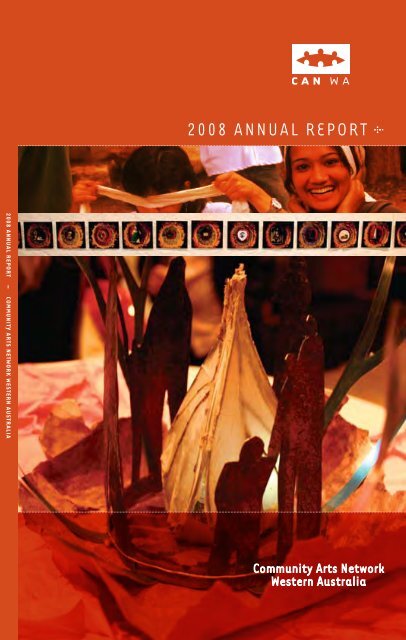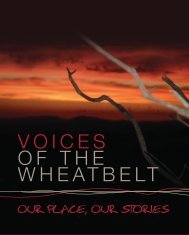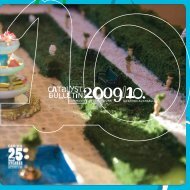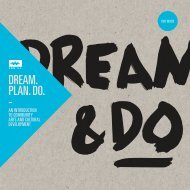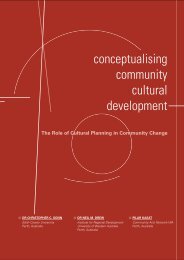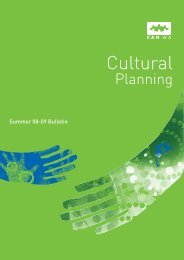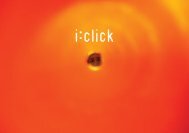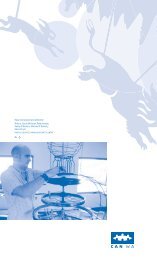Part 1 PDF 2.3 MB - Community Arts Network Western Australia
Part 1 PDF 2.3 MB - Community Arts Network Western Australia
Part 1 PDF 2.3 MB - Community Arts Network Western Australia
You also want an ePaper? Increase the reach of your titles
YUMPU automatically turns print PDFs into web optimized ePapers that Google loves.
2008 ANNUAL REPORT – COMMUNITY ARTS NETWORK WESTERN AUSTRALIA<br />
2008 ANNUAL REPORT
<strong>Community</strong> <strong>Arts</strong> <strong>Network</strong> WA acknowledges the following organisations for<br />
their support in our activities.<br />
CAN WA manages the Catalyst <strong>Community</strong> <strong>Arts</strong> Fund<br />
and <strong>Community</strong> Culture Fund on behalf of the State of<br />
<strong>Western</strong> <strong>Australia</strong>, through the Department of Culture<br />
and the <strong>Arts</strong> and supported the Yok Yurk Women’s<br />
Choir project.<br />
<strong>Australia</strong> Council for the <strong>Arts</strong>, the <strong>Australia</strong>n<br />
Government’s arts funding and advisory body, supports<br />
<strong>Community</strong> <strong>Arts</strong> <strong>Network</strong> WA Ltd, the Indigenous <strong>Arts</strong><br />
and Cultural Development program and supported the<br />
Rock Hole Long Pipe project in 2008.<br />
Healthway supported the Badjaling Nyungar Cultural<br />
Festival and the Healthway International <strong>Arts</strong> and<br />
Health Fellowship.<br />
Sharing Stories community sponsorship fund is<br />
sponsored by Healthway to promote Relationships<br />
<strong>Australia</strong>’s Make Time to Talk message and is managed<br />
by <strong>Community</strong> <strong>Arts</strong> <strong>Network</strong> WA Ltd<br />
FaHCSIA supported the Water Dreaming project,<br />
the Voices of the Wheatbelt project and the Healthway<br />
International <strong>Arts</strong> in Health Fellowship.<br />
CAN WA and the City of Stirling are partners in the<br />
Liveworx Fired Up-Sparking <strong>Arts</strong> and Creativity<br />
program.<br />
CAN WA and the City of Gosnells are partners in the<br />
Liveworx Fired Up-Sparking <strong>Arts</strong> and Creativity program.<br />
Indigenous <strong>Arts</strong> and Cultural Development Office,<br />
Kellerberrin.<br />
The Office of Multicultural Interests supported the<br />
Drawing Out <strong>Community</strong> Empowerment research project.<br />
Country <strong>Arts</strong> WA supported the Rock Hole Long Pipe<br />
project in association with the Regional <strong>Arts</strong> Fund (an<br />
<strong>Australia</strong>n Government Initiative supporting the arts in<br />
regional, remote and very remote/isolated <strong>Australia</strong>).<br />
The Rock Hole Long Pipe project was proudly supported by the Shire of Coolgardie, the Coolgardie<br />
Aboriginal Parent Directed School and the following organisations:<br />
RURAL<br />
CLINIC<br />
SCHOOL<br />
CAN WA is a registered training organisation.<br />
<strong>Community</strong> <strong>Arts</strong> <strong>Network</strong> WA<br />
PERTH OFFICE<br />
King Street <strong>Arts</strong> Centre PO Box 7514 t. +61 (08) 9226 2422 free call 1800 681 021<br />
357-365 Murray Street Cloisters Square f. +61 (08) 9226 2230<br />
Perth WA 6000 Perth WA 6850 e. admin@canwa.com.au www.canwa.com.au<br />
KELLERBERRIN OFFICE<br />
8 Ripper Street t. +61 (08) 9045 4766<br />
Kellerberrin WA 6410 f. +61 (08) 9045 4070
2008 ANNUAL REPORT<br />
Contents<br />
Section 1<br />
About Us. . . . . . . . . . . . . . . . . . . . . . . . . . . . . . . . . . . . . . . . . . . . . . . . . . . . . . . . . . . . . . . . . . . . . . . . . . . . . . . . . . . . . . . . . . . . 3<br />
CAN WA’s Vision . . . . . . . . . . . . . . . . . . . . . . . . . . . . . . . . . . . . . . . . . . . . . . . . . . . . . . . . . . . . . . . . . . . . . . . . . . . . . . . . . 4<br />
CAN WA’s Reason for Being. . . . . . . . . . . . . . . . . . . . . . . . . . . . . . . . . . . . . . . . . . . . . . . . . . . . . . . . . . . . . . . 4<br />
CAN WA’s Values . . . . . . . . . . . . . . . . . . . . . . . . . . . . . . . . . . . . . . . . . . . . . . . . . . . . . . . . . . . . . . . . . . . . . . . . . . . . . . . . 4<br />
Strategic Objectives for CAN WA 2006-2008 . . . . . . . . . . . . . . . . . . . . . . . . . . . . . . . . . . 4<br />
CAN WA Board of Directors from May 2008 . . . . . . . . . . . . . . . . . . . . . . . . . . . . . . . . . . . . 5<br />
CAN WA Team . . . . . . . . . . . . . . . . . . . . . . . . . . . . . . . . . . . . . . . . . . . . . . . . . . . . . . . . . . . . . . . . . . . . . . . . . . . . . . . . . . . . . 6<br />
CAN WA Brief Background. . . . . . . . . . . . . . . . . . . . . . . . . . . . . . . . . . . . . . . . . . . . . . . . . . . . . . . . . . . . . . . . . 7<br />
Section 2<br />
Reports. . . . . . . . . . . . . . . . . . . . . . . . . . . . . . . . . . . . . . . . . . . . . . . . . . . . . . . . . . . . . . . . . . . . . . . . . . . . . . . . . . . . . . . . . . . .11<br />
Chairperson’s Report . . . . . . . . . . . . . . . . . . . . . . . . . . . . . . . . . . . . . . . . . . . . . . . . . . . . . . . . . . . . . . . . . . . . . . .12<br />
Managing Director’s Report. . . . . . . . . . . . . . . . . . . . . . . . . . . . . . . . . . . . . . . . . . . . . . . . . . . . . . . . . . . .14<br />
Program Reports. . . . . . . . . . . . . . . . . . . . . . . . . . . . . . . . . . . . . . . . . . . . . . . . . . . . . . . . . . . . . . . . . . . . . . . . . . . . . .16<br />
Organisational Staff Chart . . . . . . . . . . . . . . . . . . . . . . . . . . . . . . . . . . . . . . . . . . . . . . . . . . . . . . . . . . . . .32<br />
CAN WA Team Diary 2008 . . . . . . . . . . . . . . . . . . . . . . . . . . . . . . . . . . . . . . . . . . . . . . . . . . . . . . . . . . . . . . . . .33<br />
Section 3<br />
Report against CAN WA objectives . . . . . . . . . . . . . . . . . . . . . . . . . . . . . . . . . . . . . . . . . . . . . . . .37<br />
Section 4<br />
Acknowledgements . . . . . . . . . . . . . . . . . . . . . . . . . . . . . . . . . . . . . . . . . . . . . . . . . . . . . . . . . . . . . . . . . . . . . . . .57<br />
Section 5<br />
Financial Statements. . . . . . . . . . . . . . . . . . . . . . . . . . . . . . . . . . . . . . . . . . . . . . . . . . . . . . . . . . . . . . . . . . . . .63<br />
2008 ANNUAL REPORT | 1
2 | 2008 ANNUAL REPORT<br />
Voices of the Wheatbelt<br />
Aubrey Nelson<br />
PHOTO, JAMES BERLYN<br />
MERREDIN SENIOR HIGH SCHOOL
Section 1<br />
ABOUT US<br />
2008 ANNUAL REPORT | 3
CAN WA’s Vision<br />
CAN WA’s vision is to inspire and mobilise communities to explore, express<br />
and grow their local and unique culture.<br />
CAN WA’s Reason for Being<br />
CAN WA’s exists to facilitate and support community-determined arts and<br />
culture activities that express local culture and identity.<br />
CAN WA’s Values<br />
Social justice<br />
Cultural freedom<br />
Cultural diversity<br />
Self-determination<br />
Principled practice<br />
Sustainability<br />
Strategic Objectives for CAN WA 2006-2008<br />
NETWORK<br />
Strengthen the relevance of the network, continuing to provide specialised community<br />
cultural development (CCD) advice, expertise, resource opportunities and support to<br />
artists and communities.<br />
GOVERNANCE<br />
Progress CAN WA’s position as a peak CCD body in WA through improved governance,<br />
including accountability and fi nancial management.<br />
COMMUNITIES<br />
Increase the opportunities for artists and communities to come together and explore<br />
CCD processes that express their culture and local identity.<br />
LEADERSHIP<br />
Increase access to, and participation in, community determined culture and arts<br />
activities through championing and nurturing opportunities to debate, raise awareness<br />
and infl uence CCD related policy and practice across the community, local and state<br />
government sectors.<br />
SKILLS DEVELOPMENT & TRAINING<br />
Capitalise on CAN WA’s unique position in <strong>Western</strong> <strong>Australia</strong> as an Registered Training<br />
Organisation (RTO) in the arts and cultural sector.<br />
4 | 2008 ANNUAL REPORT
CAN WA’s Patron<br />
Peter Newman<br />
PROFESSOR SUSTAINABILITY,<br />
CURTIN UNIVERSITY<br />
SUSTAINABILITY POLICY INSTITUTE.<br />
Board of Directors<br />
George Kingsley<br />
Chairperson<br />
LAWYER (LL.M.),<br />
REGISTRAR, DISTRICT COURT<br />
James Stewart<br />
Deputy Chairperson<br />
COUNCILLOR, CITY OF ARMADALE;<br />
MUSICIAN<br />
Brian Curtis<br />
Treasurer<br />
DIRECTOR,<br />
BRIAN CURTIS PTY LTD<br />
Alison Wright<br />
Secretary<br />
COORDINATOR,<br />
PROFESSIONAL DEVELOPMENT,<br />
CHALLENGER TAFE<br />
Professor Neil Drew<br />
Director<br />
DEAN, SCHOOL ARTS AND SCIENCES,<br />
UNIVERSITY OF NOTRE DAME<br />
Robert Ewing<br />
Director<br />
EWING ARTS, COMMUNITY<br />
DEVELOPMENT OFFICER, ARTS AND CULTURE,<br />
CITY OF ARMADALE<br />
Gwen Knox<br />
Director<br />
PROPRIETOR, BIG MAMA<br />
PRODUCTIONS, COMMUNITY CULTURAL<br />
DEVELOPMENT PRACTIONER<br />
Rachel Mordy<br />
Director<br />
TEACHER, GREAT SOUTHERN<br />
GRAMMAR SCHOOL<br />
Chris Woods<br />
Director<br />
YOUTH SERVICES COORDINATOR,<br />
CITY OF GOSNELLS<br />
Soula Vouyoucalos Veyradier<br />
Director<br />
MANAGER, MUSEUMS AND LOCAL<br />
HISTORY PORTFOLIO HEATHCOTE GALLERY,<br />
CITY OF MELVILLE<br />
Kevin McCabe<br />
Director<br />
PROPERTY ANALYST, DEPARTMENT OF<br />
CULTURE AND THE ARTS<br />
Pilar Kasat<br />
Director<br />
MANAGING DIRECTOR,<br />
CAN WA<br />
2008 ANNUAL REPORT | 5
CAN WA staff members (L to R) – James, Simone, Andrea, Pilar, Ivy, Bec, Jason, Jill, Rebecca, Barb, Ling, Frank, Brenda<br />
PHOTO, SARAH VAGLIVIELLO<br />
CAN WA team<br />
Pilar Kasat<br />
Managing Director<br />
Jeanmarie Collens (to May)<br />
Funds and Operations Manager<br />
Jason Cleary (from May)<br />
Funds and Operations Manager<br />
Barb Howard<br />
Local Government<br />
Cultural Development Manager<br />
Lauren Holst (to October)<br />
Cultural and Strategic Development<br />
Ivy Penny (from October)<br />
Cultural and Strategic Development<br />
Simone Ruane<br />
Manager, Youth <strong>Arts</strong> and Culture<br />
Natalie Scholtz (to August)<br />
Youth <strong>Arts</strong> Project Officer<br />
Jill Brown (from March)<br />
Funding Project Officer<br />
Andrea Hammond<br />
Manager, Special Projects<br />
Frank Walsh<br />
Indigenous <strong>Arts</strong> and Cultural Development Manager<br />
Rebecca Fitzgerald (to April)<br />
Indigenous <strong>Arts</strong> and Cultural Development<br />
Office Administrator<br />
Brenda McIntosh (from May)<br />
Indigenous <strong>Arts</strong> and Cultural Development<br />
Office Administrator<br />
Ling Lee<br />
Accountant<br />
Nicole Warren (to April)<br />
Office Administrator<br />
Rebecca Speidel (from May)<br />
Communications Officer<br />
Fiona Brown (to November)<br />
Administrative Assistant<br />
Kate Illes Fealy (to December)<br />
Administrative Assistant<br />
6 | 2008 ANNUAL REPORT
CAN WA – brief<br />
background<br />
CAN WA has a rich history dating back to the early 1980’s, evolving from<br />
a community art network towards its current position in advocacy,<br />
training and support for community determined arts and cultural activities.<br />
Since its incorporation more than twenty years ago, CAN WA has<br />
experienced considerable changes in its internal structure and in its<br />
service provision. Although some of the rhetoric and the jargon of<br />
the <strong>Network</strong> has changed, and the organisation has gone through<br />
several transformations since those early days, CAN WA remains<br />
true to its foundation of empowering communities through arts and<br />
cultural development.<br />
CAN WA is now an incorporated not-for-profit company limited by guarantee<br />
with a membership base. CAN WA is governed by a Board of Directors<br />
consisting of a maximum of 12 individuals from diverse backgrounds of local<br />
government, community arts, academia, business, community development,<br />
planning, accounting and law. A full time Managing Director and a team of<br />
12 individuals, six full time and six part time staff oversee the daily operations of<br />
CAN WA.<br />
CAN WA stimulates and encourages the use of art for the expression of<br />
a community’s unique culture. As a membership-based organisation,<br />
CAN WA acts as a peak body connecting communities, culture and arts<br />
practitioners with support organisations, funding opportunities and<br />
professional development opportunities.<br />
CAN WA works to inspire communities, community cultural development,<br />
arts practitioners and other organisations by<br />
Providing leadership and support to artists and communities in<br />
community cultural development<br />
Facilitating a network and partnerships between sectors who have<br />
an interest or stake in community based culture and arts practice<br />
Providing expertise, advice and mentoring to practitioners, communities,<br />
not-for-profit organisations, government organisations and industry<br />
Delivering specialised professional development opportunities which<br />
support community-determined arts and cultural activities<br />
Promoting the value of community-determined arts and cultural activities<br />
and<br />
Providing funding opportunities through the Catalyst, <strong>Community</strong> Culture<br />
and Sharing Stories funding programs.<br />
2008 ANNUAL REPORT | 7
CAN WA has been working as a Registered Training Organisation since<br />
1999 and established the first nationally recognised training in cultural<br />
planning in WA.<br />
CAN WA is funded by the State Government of <strong>Western</strong> <strong>Australia</strong> through<br />
the Department of Culture and the <strong>Arts</strong> and by the Federal Government through<br />
the <strong>Australia</strong> Council for the <strong>Arts</strong>. CAN WA also generates its own income<br />
through the development of specialised services such as training programs<br />
and cultural development consultancies.<br />
CAN WA has a track record of initiating best practice in community cultural<br />
development and has a demonstrated commitment towards social justice.<br />
CAN WA also recognises the importance of supporting Indigenous communities<br />
in affirming their cultural and spiritual beliefs.<br />
In 2006 CAN WA established a Regional Indigenous <strong>Arts</strong> and Cultural<br />
Development Unit in Kellerberrin, a Wheatbelt town located 200 kilometres<br />
east of Perth.<br />
This unit houses two Indigenous employees, whose brief is to assist and<br />
develop Indigenous self-determined arts and cultural activities in the<br />
Eastern Wheatbelt.<br />
8 | 2008 ANNUAL REPORT
10 | 2008 ANNUAL REPORT<br />
Rock Hole Long Pipe<br />
Hedge Bandits with teacher Kiera Hill<br />
and students from Kambalda<br />
PHOTO, MIKE GRAY
Section 2<br />
REPORTS
Chairperson’s report<br />
In a time of economic hardship, community arts practice can be a foundation<br />
for empowerment of communities, where art is used to improve the quality<br />
of life, promote social inclusion and grow community. Now is a time to support<br />
communities and identify solutions to local issues, in turn building resilience<br />
and maintaining a sense of identity in these challenging times.<br />
We believe that is critical for community artists to be out there practising<br />
their craft and assisting communities in strengthening their social fabric.<br />
CAN WA invites community artists and cultural workers to join us in<br />
advocating the benefits of community, building and retaining social capital<br />
through arts and culture. CAN WA has developed the credibility and a track<br />
record in bringing communities together and achieving results, both with<br />
government agencies and local authorities.<br />
David Malone,<br />
Executive Director,<br />
Healthway;<br />
Pilar Kasat,<br />
Managing Director,<br />
CAN WA;<br />
Hon. Dr. Kim Hames MLA,<br />
Deputy Premier,<br />
Minister for Health;<br />
Indigenous Affairs at the<br />
2008 Healthway <strong>Arts</strong> in<br />
Health Fellowship Finale.<br />
2008 was a period of consolidation for CAN WA as the peak body for<br />
community arts and cultural development in <strong>Western</strong> <strong>Australia</strong>. One of the<br />
most significant achievements for the year was securing a tripartite agreement<br />
with the <strong>Australia</strong> Council for the <strong>Arts</strong> and the Department of Culture and the<br />
<strong>Arts</strong> as the peak organisation in <strong>Western</strong> <strong>Australia</strong> to provide support and<br />
services for community arts and cultural development.<br />
The year was also marked by two regional community arts projects developed<br />
and produced by CAN WA. The Rock Hole Long Pipe project in Coolgardie and<br />
the Voices of the Wheatbelt project in the Eastern Wheatbelt proved to be the<br />
largest and most successful projects CAN WA has undertaken in its 24 year<br />
history. The success of these projects was founded on a long term and<br />
sustained community engagement and consultation process. Rock Hole Long<br />
Pipe brought communities and individuals, both Indigenous and non-Indigenous,<br />
together to celebrate their culture and history. For me the highlight of this<br />
event was the performance of a particular dance by the Coonana Mob that<br />
had not been performed in the area for forty years.<br />
The Voices of the Wheatbelt project saw over 200 students and adults from the<br />
Eastern Wheatbelt taking part in a photographic exploration of their sense of<br />
place and community. Diverse groups from the community, Indigenous and<br />
non-Indigenous, young and old, came together to celebrate their place and<br />
challenge some of the stereotypical views of the Wheatbelt. These projects<br />
demonstrate a new capacity of CAN WA to develop and produce best practice<br />
community arts and cultural development projects, successfully attracting<br />
$500,000 additional project funding from non-arts sources.<br />
Nationally, CAN WA has taken a pivotal role in advocacy and strengthening<br />
partnership with similarly focused organisations. Our Managing Director has<br />
been nominated as one of two spokespeople for AusCAN, a national coalition<br />
of community arts and cultural development agencies. AusCAN advocates<br />
at the Federal level, this year meeting with the Minister for Environment,<br />
Heritage and the <strong>Arts</strong>, Peter Garrett. An additional reflection of the national<br />
12 | 2008 ANNUAL REPORT
George Kingsley, Chairperson and<br />
Dr. Noel Nannup at the 2008 Healthway<br />
<strong>Arts</strong> in Health Fellowship<br />
reputation that CAN WA has gained over the past<br />
triennium, was securing a major Creative Communities<br />
<strong>Part</strong>nership project from the <strong>Australia</strong> Council,<br />
attracting over $500,000 in funding for a two-year<br />
strategic initiative.<br />
All this could not be achieved without the dedication,<br />
commitment and vision of Pilar Kasat, our Managing<br />
Director and the staff of CAN WA. In her role, Pilar’s leadership generates an<br />
environment that values each individual and their contribution, creating a fun,<br />
productive and dedicated team. Not only supported by the CAN WA team, Pilar<br />
is equally supported by the Board of Directors who continue to provide<br />
organisational strategic direction. Our diverse composition, including regional<br />
membership, gives the Board unique perspective, lending the credibility and<br />
stability required to continue to enact our vision. For this, I wish to express my<br />
heartfelt thanks to both the staff and Board.<br />
Throughout 2009 CAN WA will continue to create opportunities for people of<br />
all cultures to explore and express their identity through cultural engagement.<br />
CAN WA has never had a policy of the ‘quick fix’ but has opted for the strength<br />
of long and meaningful engagement. This approach means that we work towards<br />
strong and sustainable connections into the future. My hope is that funding<br />
agencies recognise the importance of such an approach and continue to<br />
support community arts practice in strengthening community wellbeing.<br />
George Kingsley<br />
Chairperson<br />
2008 ANNUAL REPORT | 13
Managing Director’s<br />
report<br />
2008 was an extraordinary year for CAN WA.<br />
So what made 2008 so fantastic It was a year in which we consolidated<br />
partnerships with key agencies and individuals, secured a further round of<br />
triennial funding and boosted our operating budget beyond $1.5 million. These are<br />
amazing achievements for a small organisation in the community arts sector.<br />
During the first half of 2008, we undertook a business and strategic planning<br />
process. The Business and Cultural Plan articulates a clear vision and purpose<br />
that forms the foundation of a new strategic direction. With this plan, we secured<br />
funding from the <strong>Australia</strong> Council and the Department of Culture and the <strong>Arts</strong>,<br />
giving us a stable core for 2009-2011. We move forward with a clear set of<br />
objectives and strategies to accomplish in the next three years.<br />
Our position in <strong>Western</strong> <strong>Australia</strong> was consolidated, with the <strong>Australia</strong> Council<br />
and the Department of Culture and the <strong>Arts</strong> determining CAN WA to be the<br />
peak service organisation for community arts and cultural development in WA.<br />
In 2008 CAN WA produced and delivered significant community arts and<br />
cultural development projects. Projects such as the Badjaling Nyungar<br />
Cultural Festival, Rock Hole Long Pipe and Voices of the Wheatbelt projects<br />
are testimony of what a community is capable of when culturally appropriate<br />
engagement and committed processes are applied. These projects nurtured<br />
and united communities because they were relevant and meaningful to all<br />
involved. I’d like to say thank you to all those who embraced these<br />
opportunities – their enthusiasm made these projects momentous.<br />
Rock 14 Hole | Long 2008 Pipe ANNUAL REPORT<br />
Peter Docker as Captain Cool Guardia<br />
PHOTO, MIKE GRAY
We secured some major future projects in 2008. Consolidation of our work in<br />
the Eastern Wheatbelt secured a very exciting strategic partnership with four<br />
shires from the Eastern Wheatbelt. <strong>Australia</strong> Council for the <strong>Arts</strong> have become<br />
a key partner along with the Department of Culture and the <strong>Arts</strong> and Healthway.<br />
This project secured over $500,000 and a whole host of other partnerships and<br />
relationships with the Nyungar community and other key stakeholders.<br />
CAN WA staff at<br />
Badjaling Nyungar<br />
Cultural Festival<br />
PHOTO, CAN WA<br />
A research report written by Dr Meredith Green and Dr Christopher Sonn,<br />
funded by the Office of Multicultural Interests was published in August 2008.<br />
This evaluation looked at the effectiveness of our work in the Eastern Wheatbelt<br />
and in particular examines CAN WA’s work under the theories of empowerment.<br />
I am extremely happy to report that according to the research, CAN WA<br />
methodologies are contributing to the empowerment of the Nyungar community.<br />
More work is needed and further collaboration with other agencies has the<br />
potential to strengthen this model.<br />
We had a year of significant staff changes<br />
and lost some wonderful people, but also<br />
gained some equally amazing people.<br />
I would personally like to thank the staff for<br />
their continued dedication and commitment.<br />
Both present and past, the people that have<br />
passed through our doors have continued<br />
the vision that upholds our organisation.<br />
The Board of Directors continue to give<br />
CAN WA a sense of strategic direction,<br />
supporting the organisation with their diversity<br />
and skills. I wish to thank and acknowledge<br />
their commitment and support that they<br />
provide to me, our staff and the organisation<br />
as a whole. Our Chair, George Kingsley<br />
gives his time and expertise with<br />
enormous generosity, which is invaluable.<br />
CAN WA approaches 2009 as an organisation with an enhanced reputation for<br />
creativity, responsiveness, ethics and vision. Despite the recent economic<br />
downturn, we look to the future and beyond with a renewed sense of purpose<br />
and an enormous amount of optimism.<br />
Pilar Kasat<br />
Managing Director<br />
2008 ANNUAL REPORT | 15
Funding report<br />
Busselton Jetty Swim<br />
Drumming Workshops<br />
PHOTO, PETTI MCINNES<br />
After stepping into the Funds & Operations Manager role in May 2008, I must<br />
admit I was not only excited, but also nervous about managing CAN WA’s funding<br />
programs. Most of my previous experience has been receiving funding. Firstly<br />
I must thank Jeanmarie Collens for a fantastic handover and for leaving me<br />
with a thorough list of “don’t forget” tasks stuck to my pin-up board.<br />
Funding Project Officer, Jill Brown has worked tirelessly on both the Sharing<br />
Stories Fund and the <strong>Community</strong> Culture Fund. She ran these programs so<br />
smoothly that we’ll be sad to see her go on maternity leave in 2009. We wish<br />
her all the best and by the time you read this, she will have added a new<br />
member to the family.<br />
CATALYST COMMUNITY ARTS FUND<br />
One of my first major jobs was to produce the Catalyst 10th Anniversary<br />
Bulletin 1997-2007, a culmination of the hard work from many people over<br />
the ten years the fund has been running. It was great to have the Minister for<br />
Culture and the <strong>Arts</strong> launching the book before a fantastically diverse<br />
audience. Coupled with the various projects and people showcased within its<br />
pages, the bulletin proves the massive impact Catalyst has across <strong>Western</strong><br />
<strong>Australia</strong>n communities.<br />
16 | 2008 ANNUAL REPORT
Guests at the launch of<br />
the 10th Anniversary<br />
Catalyst bulletin, 2008<br />
PHOTO, CAN WA<br />
Not long after, I conducted my first round of Catalyst funding. It was a great<br />
experience and I have loved every minute – from getting people thinking about<br />
applying and attending the workshops, through to acquitting the successful projects<br />
and seeing the amazing amount of work communities put into these projects.<br />
In 2008 we had 50 applications for Catalyst funding. 41 of these projects received<br />
funding for a total amount of $240,612. Of the applications received, 31 of these<br />
were based in the metropolitan area and 19 regionally.<br />
2008 PROJECT HIGHLIGHTS:<br />
Although all Catalyst projects are deserving of mention, I have picked out,<br />
with difficulty, some highlights from the 34 projects that were acquitted in 2008.<br />
Reduce Your Energy Use – The City of South Perth<br />
The City of South Perth continued their environmental theme from 2007<br />
with Reduce Your Energy Use that saw 500 kids work with environmental<br />
artists to construct kinetic sculptures from natural materials. Solar panels and<br />
wind generators were installed to power the exhibition at night during the<br />
City of South Perth Fiesta.<br />
Southwest Project – The Kaleidoscope Ensemble<br />
The Kaleidoscope Ensemble’s Southwest Project bought theatre and ‘string can’<br />
instruments to a group of students from Wilson Park Primary School in Collie,<br />
ending with a fantastic community performance at Ferguson Valley Farmstay.<br />
In Her Stride, In Her Pride - Lesbi Visible Mental Health Program<br />
The Lesbi Visible Mental Health Program produced some amazing artworks<br />
including vibrant masks and sculptures. The project focused on giving lesbian<br />
and bisexual women with mental health issues an opportunity to explore and<br />
validate their sexual choice and identity.<br />
Kattidj project,<br />
City of Mandurah, 2008<br />
PHOTO COURTESY OF<br />
CITY OF MANDURAH<br />
SHARING STORIES AND COMMUNITY CULTURE FUNDS<br />
In 2008, the Sharing Stories <strong>Community</strong> Art Fund, sponsored by Healthway to<br />
promote Relationships <strong>Australia</strong>’s ‘Make Time to Talk’ message took on a more<br />
targeted approach. Sharing Stories exclusively supported arts projects in the<br />
Goldfields and Wheatbelt regions that encouraged community participation,<br />
creative expression and relationship building in a safe environment with a<br />
particular focus on young people. The fund also underwent significant development<br />
in the form of revised guidelines and a streamlined application form.<br />
Six projects were supported through the 2008 Sharing Stories <strong>Community</strong><br />
Sponsorship Fund. The projects will take place in Quairading, Merredin,<br />
Kellerberrin, Moora and Narrogin in the early part of 2009 across a range of<br />
artforms. Technology played a significant role in the 2008 Sharing Stories projects,<br />
with DVD, digital art and audio recording being some of the artforms used to<br />
bring communities together to express their ideas.<br />
2008 ANNUAL REPORT | 17
Merredin<br />
A week of workshops and consultations with visiting Digital Artist Jeremy Lynch,<br />
will culminate in a series of projections at local wheat silos. Diverse groups,<br />
such as young and Indigenous people, will have the opportunity to engage in<br />
targeted workshops throughout the week, with all participants being encouraged<br />
to work together as a diverse group to create the showcase event.<br />
The <strong>Community</strong> Culture Local Government Regional Cultural Planning Fund,<br />
sponsored by the State of <strong>Western</strong> <strong>Australia</strong> through the Department of<br />
Culture and the <strong>Arts</strong>, provided a way for local governments to explore their<br />
communities’ collective identities, values and aspirations with the aim of<br />
informing decision making and planning.<br />
Thirteen applications were received in 2008 and seven projects were funded<br />
for a total of $98,718. Successful Cultural Planning applicants included Shire of<br />
Denmark, Shire of Broome and the Shire of Chapman Valley. The funding<br />
received will enable each of these Shires to produce a Cultural Plan to help<br />
determine how best to use cultural resources for economic and social<br />
development. Successful Cultural Mapping applicants included Shire of<br />
Morawa, Shire of West Arthur, City of Bunbury and the Albany Aboriginal<br />
Heritage Group. Cultural mapping includes a range of art forms and<br />
approaches to community cultural development.<br />
Albany Aboriginal Heritage Group<br />
The Albany Aboriginal Heritage Group, with the support of the City of Albany,<br />
will take young Nyungar people on an inspirational and connective cultural<br />
tour with local Nyungar elders. The tour will stimulate fresh stories for<br />
sharing with the youth, building stronger communities, a sense of belonging,<br />
ownership and inspiration for artwork. These verbally shared stories will be<br />
recorded and sculptural workshops will follow with Nyungar artist Lance<br />
Chadd (Tjyllyoungoo). The sculptures created will be placed within the<br />
Nyungar garden located at the WA Museum at Albany.<br />
Every successful applicant deserves congratulations on the hard work and<br />
energy in bringing their projects together.<br />
Both myself and Jill would like to give a big round of applause to the fabulous<br />
Selection Panel Members who gave their time in 2008, Sarah Wilkinson from<br />
the Department of Culture and <strong>Arts</strong> and the wonderful staff and Board at CAN<br />
WA who have made me feel part of the ‘furniture’ so quickly. I look forward to<br />
2009 and managing the ‘new look’ funding program on behalf of CAN WA.<br />
Jason Cleary<br />
Operations and Funding Manager<br />
Jill Brown<br />
Funding Project Officer<br />
18 | 2008 ANNUAL REPORT
The Garden Project<br />
Artists: Audrey Satar & Arif Satar<br />
PHOTO COURTESY THE ARTISTS<br />
2008 ANNUAL REPORT | 19
Cultural Planning and<br />
Development report<br />
From what I’ve heard, 2008 has yet again been a very exciting year<br />
with some great projects and partnerships forged here at CAN WA.<br />
Sadly, this year CAN WA bid farewell to Lauren Holst as she jetted off to<br />
pursue new adventures in Melbourne. As I prepare to step into Lauren’s<br />
role in Strategic and Cultural Development, I gained an insight into all<br />
that Lauren has brought to CAN WA during her time here. Her ability<br />
to work across art forms, bring together diverse groups of people<br />
and manage the multiple projects on the go has been a huge asset<br />
to the organisation.<br />
Ivy Penny<br />
Manager Strategic and Cultural Development<br />
In 2008, renovating CAN WA’s Cultural Planning Course was at the top of<br />
the to-do list. With the help of some fantastic new presenters and Simone<br />
Ruane co-facilitating the course, we’ve created CAN WA’s new and improved,<br />
nationally accredited, Cultural Planning Course.<br />
One of our first changes was the decision to put a new spin on the timetabling of<br />
the course. The first three intense days of the training were delivered<br />
consecutively, followed by a six-week break for participants. This allowed<br />
them to soak in all of the knowledge and be ready to come back for the final<br />
two days of the course with questions and anecdotes from their fieldwork and<br />
readings. Both the participants and myself found this formula to work really<br />
well. The format also enabled regional participants to be more easily involved<br />
in the course than in some previous years. Several new assessments have<br />
been added to the course requirements for students who wish to obtain the<br />
national accreditation in the units of ‘Devising and Conducting <strong>Community</strong><br />
Consultations’ and ‘Developing and Implementing <strong>Community</strong> Cultural Plans’.<br />
We began the training in mid May 2008 with participants from as far a field<br />
as Mullewa, Morawa, Kalgoorlie, Merredin and metropolitan Perth, and from<br />
sectors as diverse as arts and events management, local government policy<br />
development, art therapy and community development. This ensured that<br />
group discussions were never dull and different opinions and experiences<br />
were voiced.<br />
I quickly realised in the lead up to the 2007 course, that visualizing beautiful<br />
weather plays a large part in the ambience and our enjoyment of the first day.<br />
Sure enough, the good weather vibes paid off, as we were able to enjoy an<br />
afternoon of tasty morsels and storytelling in the middle of May. This was all<br />
in the presence of a very warm hearted individual who I would argue is one<br />
of the most spellbinding storytellers in Perth, Mr Noel Nannup.<br />
Voices of the Wheatbelt<br />
PHOTO, GEORGIANNA CRANE<br />
TAMMIN PRIMARY SCHOOL<br />
20 | 2008 ANNUAL REPORT
Voices of the Wheatbelt<br />
PHOTO, ALFRED MCGRATH<br />
MERREDIN SENIOR HIGH SCHOOL<br />
Noel gave participants an insight into the dreaming stories and Indigenous<br />
history of the Perth metro area in the stunning setting of Kings Park.<br />
Day two jumped straight into learning, demonstrating and participating in a wide<br />
variety of community consultation methods. Firstly Dr Natalie McGrath shared<br />
her abundance of knowledge and experience in the area, specifically regarding<br />
involving Indigenous community members in meaningful consultation.<br />
Following a presentation on the principles, examples and a group exercise<br />
in cultural mapping, the ever-exuberant Anne Sorenson got everyone up and<br />
about illustrating how drama techniques can allow many different people,<br />
who may not normally engage in more traditional methods, to contribute to<br />
the consultation process.<br />
After looking at the principles and building blocks of a cultural plan, day three<br />
of the course concentrated on various methodologies and frameworks to<br />
achieving a successful cultural plan with community ownership. Sandra Krempl<br />
once again shared her wealth of experience and enthusiasm to the group who<br />
were left awe-inspired by her passionate delivery.<br />
After our six-week break, the intensity of the first three days was quickly<br />
restored to the group, especially given that the focus of day four was evaluation.<br />
A difficult topic to be excited about in the eyes of most, however Julia Anwar-<br />
McHenry brought passion to the subject and a great deal of skill in her<br />
communication of many complex methods of evaluation. We also looked at<br />
how we all could best communicate the concepts and value of the cultural<br />
planning process to others.<br />
On the final day of the training, it was a great pleasure to hear the participants<br />
convey their own ideas about the benefits and outcomes of cultural planning<br />
in-group presentations. The course was rounded off with a superb industry<br />
panel comprising of Lindsay Bridge (Department of Local Government and<br />
Regional Development), Kevin Knapp (City of Belmont), and Frank Walsh<br />
(CAN WA’s Indigenous Unit in Kellerberrin). Each of the panel speakers have a<br />
wide array of experiences regarding improving the engagement of Indigenous<br />
people with local government and this was the common thread which ran<br />
throughout the discussion. In the final evaluation of the course, participants<br />
spoke very highly about the value, insight and usefulness of the discussion<br />
about this very pertinent issue.<br />
It was my great privilege to work together with all of the presenters in this year’s<br />
course and extremely satisfying to be able to assist with the learning and skills<br />
development of each of the participants. It’s always a pleasure and I too learn<br />
many new skills each year from all of you!<br />
Lauren Holst<br />
Strategic and Cultural Development<br />
2008 ANNUAL REPORT | 21
Youth <strong>Arts</strong> and Culture<br />
report<br />
2008 was a year of consolidation for CAN WA’s Youth <strong>Arts</strong> and Culture Program.<br />
The previous three years of relationship building, research, consultation and<br />
pilot programs had provided CAN WA with a strong base to deliver well thought<br />
out, quality programs to young people, particularly focussing on Indigenous<br />
people, new migrants and those not thriving in mainstream education. All of<br />
CAN WA’s 2008 youth programs combined a community cultural development<br />
approach with vocational training outcomes and provided an avenue for young<br />
people to explore issues and express themselves through arts and creativity.<br />
The program allows young people to make new friends, access relevant<br />
information and support, and build new skills.<br />
CAN WA continued to work closely with the City of Stirling to deliver<br />
three Fired Up programs in 2008 as part of the Reel Connections Initiative.<br />
Reel Connections aims to harness the strengths of the cultural diversity<br />
found in the Mirrabooka, Balga and Girraween areas and to enhance the<br />
relationships between culturally and linguistically diverse, Indigenous and<br />
mainstream young people. The Fired Up programs in 2008 utilised diverse<br />
artforms including drama, music, film, photography, Capoeira, urban arts,<br />
textiles and murals; as a way of engaging young people in a positive learning<br />
and community experience. The success of the Fired Up program and the<br />
Reel Connections Initiative as a whole has been underpinned by a strong<br />
partnership model in which CAN WA, the City of Stirling, Balga Detached Youth<br />
Support Services, Filmbites Youth Film Company, the City of Wanneroo and the<br />
WA police collaborate to share resources and expertise. The Fired Up program<br />
will be continued to be delivered through Reel Connections until mid 2010.<br />
As part of the City of Gosnells Straight Talking Initiative, CAN WA worked in<br />
partnership with the City of Gosnells and Filmbites to provide community arts<br />
and vocational training opportunities for young people, primarily those residing<br />
in the Maddington and Kenwick areas whose needs are not being met by mainstream<br />
education. The ‘Risky Bizness’ Program is a drama and film-based<br />
educational program that explores the causes and consequences of behaviours<br />
that may result in injury and death, with a particular focus<br />
on road safety, hooning behaviours and safe communities.<br />
Young participants work towards the production of a<br />
short film based on this theme. This will be utilised in the<br />
future as an educational resource tool in the local schools.<br />
Two Risky Bizness programs were delivered in 2008 in<br />
partnership with Yule Brooke College, Seven Oakes College<br />
and VIP Plus Communicare. Risky Bizness programs will<br />
continue to be delivered through the Straight Talking<br />
Initiative in 2009 and 2010.<br />
22 | 2008 ANNUAL REPORT
In 2008 CAN WA also worked with the City of Gosnells and public artist Jahne<br />
Rees to provide an opportunity for young people to be involved in designing a<br />
skate-able public artwork in Westfield Park Skate Facility in Maddington.<br />
The Maddington Skate Park Users group contributed to the design of the<br />
sculpture that utilised photos taken by the young CAN WA LiveworX<br />
Maddington and Kenwick 2007 program participants. The Mayor of Gosnells,<br />
Cr Olwen Searle, unveiled the artwork in early December.<br />
Published in the Summer 2008/09, the Liveworx publication featured articles<br />
from a range of individuals and organisations that have been utilising community<br />
arts practice in their work with young people. The articles showcase some<br />
practical and creative examples of community cultural development work that<br />
contributes to enhancing the wellbeing of young people in meaningful ways.<br />
2008 was a very busy and productive year for CAN WA’s Youth <strong>Arts</strong> and Culture<br />
Program. All of the activities undertaken could not have been possible without<br />
the involvement of many key individuals and organisations who are keenly<br />
supportive of a community cultural development approach with young people.<br />
In particular I would like to express my sincere thanks to the following people<br />
for their contributions to CAN WA youth programs and activities:<br />
Sarah Janali, City of Stirling<br />
Jahne Rees, public artist<br />
Jaime Yallup, RRAFT Educators<br />
Mike Dixon, Balga Detached Youth Support Services<br />
Chris Woods, City of Gosnells<br />
Deb Ditchburn, City of Gosnells<br />
Hallie McGeig, Filmbites Youth Film Company<br />
Gregg Johnson, Filmbites Youth Film Company<br />
Claire Hanna, qalamDESIGN<br />
Gillian Gatlow, The Kaleidoscope Ensemble<br />
Rebecca Cockram, Country <strong>Arts</strong> WA<br />
Sonja Basic, Propel Youth <strong>Arts</strong><br />
After four years of managing CAN WA’s Youth <strong>Arts</strong> and Cultural projects, I’ll be<br />
handing over the reigns to our newly appointed Youth <strong>Arts</strong> and Culture Manager,<br />
James Berlyn in 2009. James will bring a great set of skills and fresh enthusiasm<br />
to the program, and am sure we will see it evolve to a whole new level.<br />
I will be managing CAN WA’s new Wheatbelt Strategic <strong>Part</strong>nership Initiative,<br />
collaborating with four Eastern Wheatbelt Shires and their local Nyungar<br />
communities – Bruce Rock, Kellerberrin, Quairading and Tammin – to support<br />
and enhance opportunities for Indigenous <strong>Arts</strong> and Cultural Development and<br />
participation in cultural tourism. So watch this space!<br />
Simone Ruane<br />
Manager, Youth <strong>Arts</strong> and Culture<br />
All photos –<br />
Fired Up 2008<br />
PHOTOS, CAN WA<br />
2008 ANNUAL REPORT | 23
Local Government<br />
Cultural Development<br />
report<br />
COOLGARDIE WATER DREAMING PROJECT<br />
The Coolgardie Water Dreaming Project, a two year project being undertaken<br />
by CAN WA in collaboration with the Shire of Coolgardie and funded by the<br />
Department of Families, Housing, <strong>Community</strong> Services and Indigenous Affairs<br />
is drawing to a close in June 2009. The aim of ‘Water Dreaming’ was to bring<br />
the whole Shire of Coolgardie together to explore how drought has affected<br />
the community. The project looked at how to minimise the hardships caused by<br />
drought by building community capacity and a sense of place, increasing the<br />
community’s resilience in times of difficulty. The capacity was built through<br />
creative arts, using cultural and interactive processes.<br />
ROCK HOLE LONG PIPE COMMUNITY THEATRE PERFORMANCE<br />
The central aim of community theatre performance Rock Hole Long Pipe was<br />
to involve a broad cross section of the community in an event that told the<br />
Indigenous and non-Indigenous stories of the region to create cross-cultural<br />
understanding within a community that has very little knowledge or<br />
understanding of Indigenous culture.<br />
Rock Hole Long Pipe was developed over a period of nine months and involved<br />
two schools in Coolgardie and two schools in Kambalda, local community<br />
organisations, local Indigenous and non-Indigenous elders and leaders,<br />
artists and performers from the community and elsewhere to tell the ancient<br />
and contemporary story of the water in this significant part of the Goldfields.<br />
The development phase of Rock Hole Long Pipe required extensive community<br />
consultation across the entire community, in particular with the Madawanga-<br />
Galagoo people of Coolgardie. This process was assisted through the<br />
involvement of local cultural advisors Alison Dimer, Trevor Jamieson,<br />
Alice Haines, Annette Stokes and Steven Sinclair who made introductions<br />
and facilitated discussions enabling the building of a strong platform<br />
to develop the necessary trust for the stories to be shared.<br />
Rock Hole Long Pipe<br />
Lanterns<br />
PHOTO, POPPY VAN OORDE-GRAINGER<br />
Project highlights:<br />
Artistic Director, Lockie McDonald was contracted to assist with<br />
developing a community performance in November 2007.<br />
2008 Healthway International <strong>Arts</strong> in Health Fellow Alison Clough arrived<br />
from the UK, having worked extensively in a health context for the last<br />
10 years, bringing immense experience to the project.<br />
Well-known <strong>Australia</strong>n writer/actor Peter Docker was a significant benefit to<br />
the project due to his passion, insight and sensitivity to Aboriginal cultures.<br />
Visual artist Poppy van Oorde-Grainger brought enthusiasm and energy to<br />
much more than the design elements of Rock Hole Long Pipe.<br />
24 | 2008 ANNUAL REPORT
Rock Hole Long Pipe<br />
Hedge Bandits<br />
PHOTO, MIKE GRAY<br />
Rock Hole Long Pipe<br />
The giant echidna<br />
PHOTO, MIKE GRAY<br />
One of the great moments of the performance was the students’ animations<br />
facilitated by Animator Steve Aiton. Steve’s history of growing up in Mt Isa,<br />
an environment not dissimilar to Coolgardie, fuelled his resolve to expose<br />
young people to exciting new communication tools.<br />
Musicians The Hedge Bandits ran workshops with Kambalda District High<br />
School students in the week leading up to the performance, adding<br />
musical integrity to the process.<br />
Local Artist, Alice Haines became a major conduit to the children at<br />
Coolgardie CAP School and wrote the dramatic music for the end of<br />
the performance.<br />
Trevor Jamieson opened cultural doors through his kinship with the<br />
Coonana community.<br />
A three-week workshop program was developed that involved classes from<br />
each of the schools situated in Coolgardie and Kambalda creating modules<br />
of the performance.<br />
2008 ANNUAL REPORT | 25
The performance involved the students from Coolgardie CAP School,<br />
Coolgardie Primary School, Kambalda Primary School and Kambalda District<br />
High School, the Coolgardie Volunteer Fire and Emergency Service, local poet<br />
Victor Dale, Perth band The Hedge Bandits, Perth actor Peter Docker and local<br />
actors Elizabeth Trott, Jessica Stokes and Angus Donaldson, local biker John<br />
Addink, local visual artist Catherine Howard and the Coonana Mob.<br />
COOLGARDIE WATER DREAMING BANNER PROJECT<br />
Initially Paula Hart was engaged to provide workshops to the schools in<br />
Coolgardie and Kambalda with the intention of creating imagery for a series of<br />
banners about water in the Coolgardie and Kambalda region. The preliminary<br />
meetings undertaken with the teachers at all the schools indicated that water<br />
would be a focus subject for the year and resources were provided by CAN<br />
WA to assist the teachers with their lessons.<br />
Following the workshops, Paula felt that her initial suggestion of a banner parade<br />
in the Coolgardie Day community celebrations would not translate into something<br />
that could be understood by an audience, given the students limited knowledge<br />
of water in the region. Instead she proposed the artwork was used to produce<br />
permanent artworks of a similar dimension for each school allowing the students<br />
to take their time studying the detail of the work to gain a greater understanding<br />
of the water issues in their community. This project was commenced in March<br />
2008 and concluded with an exhibition in December 2008.<br />
CULTURAL DEVELOPMENT FORUM<br />
The Cultural Development Forum Committee formed in August 2007 and met at<br />
the CAN WA office in March, June, August and December. Forums were held<br />
at the City of Melville in July and City of Belmont in November focusing on the<br />
State Government’s Ignite Package and the Percent for Art program<br />
respectively. A sub committee made up of representation from the Department<br />
of Culture and the <strong>Arts</strong>, the <strong>Western</strong> <strong>Australia</strong>n Local Government Association,<br />
and artworkers from the City of Armadale and the Town of Vincent, worked<br />
together with support provided by CAN WA to develop the Art in Public Places<br />
Symposium program. The symposium will be held at the Subiaco <strong>Arts</strong> Centre<br />
from late May to early June with the plan to have travel subsidies provided<br />
through Department of Culture and the <strong>Arts</strong> funding to enable regional cultural<br />
development officers and artworkers the chance to participate.<br />
2008 INTERNATIONAL HEALTHWAY ARTS IN HEALTH<br />
FELLOWSHIP<br />
CAN WA formed a partnership with Wongutha Birni Aboriginal Corporation and<br />
the Rural Clinical School of WA through the University of WA and Notre Dame<br />
University, to bring Alison Clough to the Goldfields as the 2008 Healthway <strong>Arts</strong><br />
in Health Visiting Fellow.<br />
Alison worked for Welfare State to create a new visual and celebratory<br />
vocabulary that has provided communities with ways to increase their health<br />
and wellbeing with very few resources. Her more recent work has had an<br />
26 | 2008 ANNUAL REPORT


